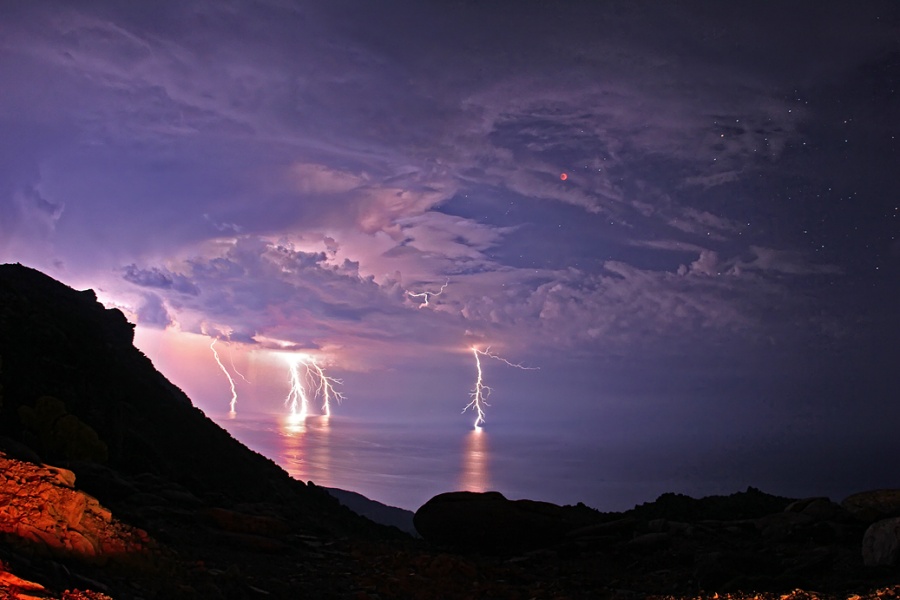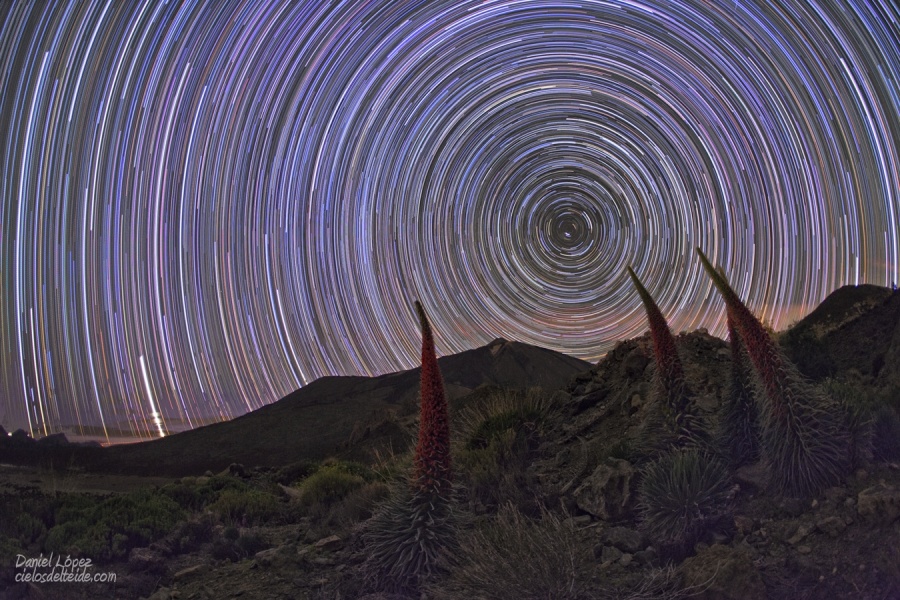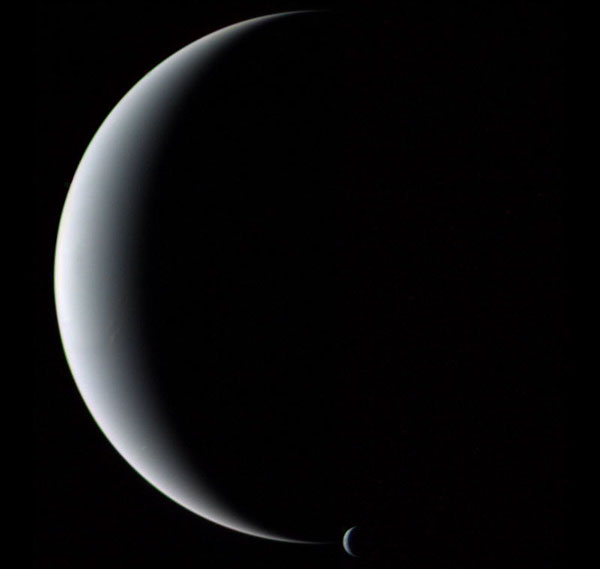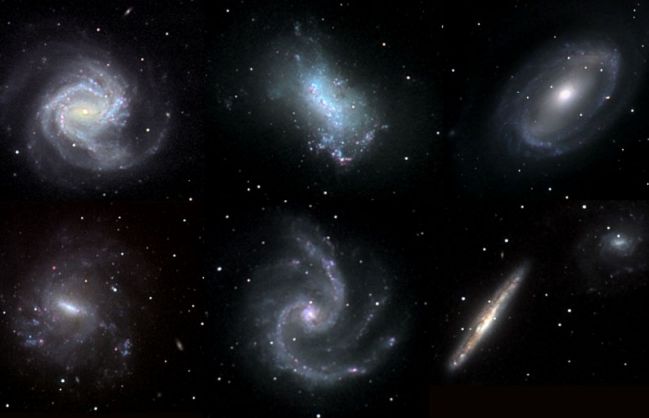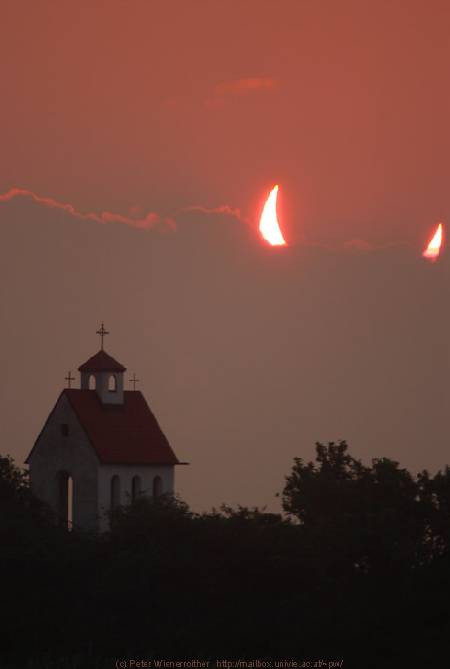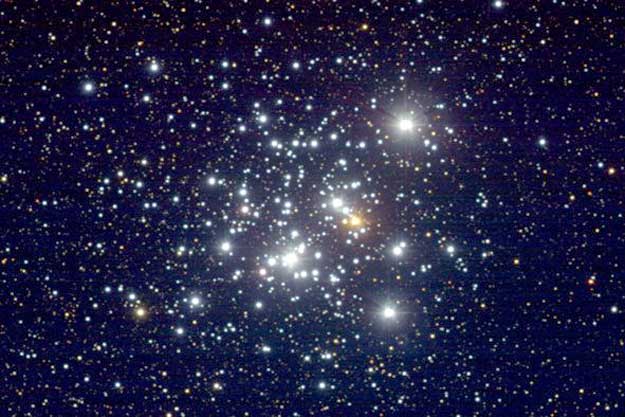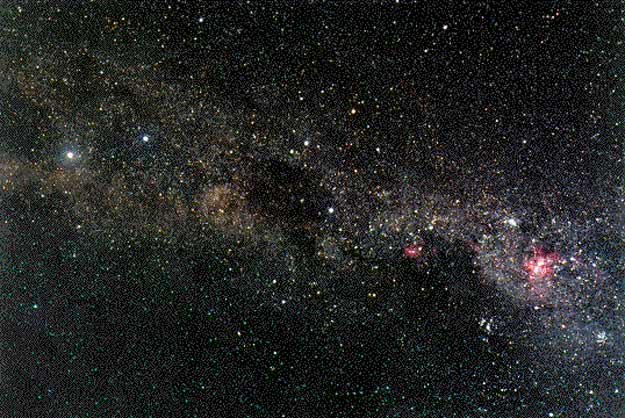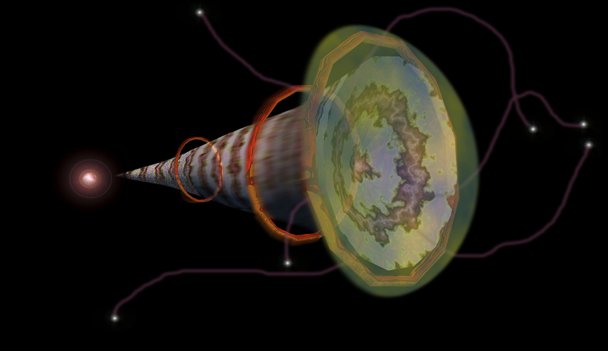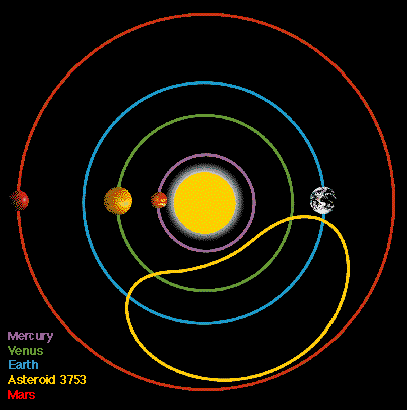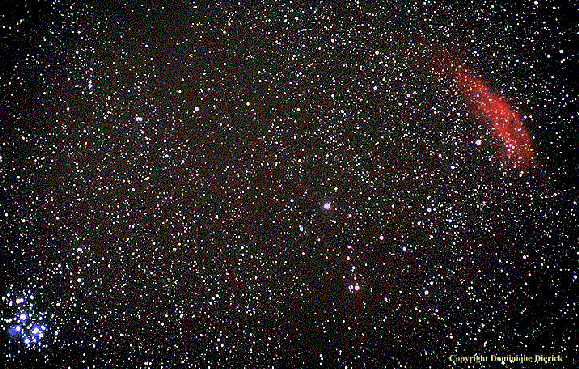| << Previous | Index | Next >> |
2015 This big, bright, beautiful spiral galaxy is Messier 64, often called the Black Eye Galaxy or the Sleeping Beauty Galaxy for its heavy-lidded appearance in telescopic views. M64 is about 17 million light-years distant in the otherwise well-groomed northern constellation Coma Berenices. In fact, the Red Eye Galaxy might also be an appropriate moniker in this colorful composition. The enormous dust clouds obscuring the near-side of M64's central region are laced with the telltale reddish glow of hydrogen associated with star forming regions. But they are not this galaxy's only peculiar feature. Observations show that M64 is actually composed of two concentric, counter-rotating systems. While all the stars in M64 rotate in the same direction as the interstellar gas in the galaxy's central region, gas in the outer regions, extending to about 40,000 light-years, rotates in the opposite direction. The dusty eye and bizarre rotation is likely the result of a billion year old merger of two different galaxies.
2014
2013
Video Credit & Copyright: Mike Olbinski; Music: Impact Lento (Kevin MacLeod, Incompetech)
2012 Why were the statues on Easter Island built? No one is sure. What is sure is that over 800 large stone statues exist there. The Easter Island statues, stand, on the average, over twice as tall as a person and have over 200 times as much mass. Few specifics are known about the history or meaning of the unusual statues, but many believe that they were created about 500 years ago in the images of local leaders of a lost civilization. Pictured above, some of the stone giants were illuminated in 2009 under the central band of our Milky Way Galaxy.
2011 Thunderstorms almost spoiled this view of the spectacular June 15 total lunar eclipse. Instead, storm clouds parted for 10 minutes during the total eclipse phase and lightning bolts contributed to the dramatic sky. Captured with a 30 second exposure the scene also inspired what, in the 16 year history of Astronomy Picture of the Day, the editor considers may be the best title yet for a picture (title credit to Chris K.). Of course, the lightning reference clearly makes sense, and the shadow play of the dark lunar eclipse was widely viewed across planet Earth in Europe, Africa, Asia, and Australia. The picture itself, however, was shot from the Greek island of Ikaria at Pezi. That area is known as "the planet of the goats" because of the rough terrain and strange looking rocks.
2010 What bizarre planet do these alien creatures inhabit? It's only planet Earth, of course. In this well-composed scene, the sky is filled with star trails around the north celestial pole. A reflection of the Earth's daily rotation on its axis, star trails are familiar to photographers who fix their camera to a tripod and make long exposures of the night sky. But the imposing forms gazing skyward probably look strange to many denizens of Earth. Found on the Canary Island of Tenerife, they are red tajinastes, rare flowering plants that grow to a height of up to 3 meters. Hidden among the rocks of the volcanic terrain, tajinastes bloom in spring and early summer and then die after their seeds mature. On the distant horizon, below and left of the celestial pole, lies the Teide volcano.
2009 NGC 6240 offers a rare glimpse of a cosmic catastrophe in its final throes. The titanic galaxy-galaxy collision is located a mere 400 million light-years away in the constellation Ophiuchus. One of the brightest sources in the infrared sky, the merging galaxies spew distorted tidal tails of stars, gas, and dust and undergo frantic bursts of star formation. The two supermassive black holes in the original galactic cores will also coalesce into a single, even more massive black hole. Soon, only one large galaxy will remain. This dramatic image of the scene is a multiwavelength composite; red colors trace infrared emission from dust recorded by the Spitzer Space Telescope, with Hubble visible light images of stars and gas in green and blue hues. The view spans over 300,000 light-years at the estimated distance of NGC 6240.
2008 What if the atmosphere above you became one gigantic lens? This actually happens when a nearly transparent sheet of pyramid shaped ice crystals falls from the sky in a common orientation. These ice-crystals act together like millions of miniature ice mirrors, with external and internal reflections from different faces creating arcs and halos of different radii. An amazing display of pyramid ice crystal halos was captured on June 5 above Tampere, Finland. Visible above are very unusual sun halos of 9, 18, 20, 23, and 24 degrees. In contrast, thin and flat falling ice crystals will produce a halo of 22 degrees only. The high clouds containing the ice crystals are faintly visible, as are some sundogs. The usual Sun image was covered behind a light post, and the above image was significantly digitally sharpened. It is not currently known how large areas of nearly uniform pyramidal ice crystals form.
2007 Exploring the myriad shapes found in the cosmic zoo of planetary nebulae, some astronomers have focused on the intriguing example of M2-9. About 2,100 light-years away and over one light-year across, M2-9 is known as a twin jet or butterfly nebula in reference to its striking bipolar symmetry. Monitoring M2-9 over many years from ground based telescopes has revealed the dramatic west to east (left to right) progression of features illustrated in this collage. The apparent motion could well be caused by an energetic rotating beam sweeping across the nebular material. Astronomers argue that the beam is collimated by interacting stellar winds in a double star system at the center of M2-9. The binary system of a giant star and hot white dwarf star orbit each other about once every 120 years. Click here to watch an animated gif of M2-9.
2006 Gliding silently through the outer Solar System, the Voyager 2 spacecraft camera captured Neptune and Triton together in crescent phase in 1989. The above picture of the gas giant planet and its cloudy moon was taken from behind just after closest approach. It could not have been taken from Earth because Neptune never shows a crescent phase to sunward Earth. The unusual vantage point also robs Neptune of its familiar blue hue, as sunlight seen from here is scattered forward, and so is reddened like the setting Sun. Neptune is smaller but more massive than Uranus, has several dark rings, and emits more light than it receives from the Sun.
2005 A tantalizing assortment of island universes is assembled here. From top left to bottom right are the lovely but distant galaxies M61, NGC 4449, NGC 4725, NGC 5068, NGC 5247, and NGC 5775/5774. Most are spiral galaxies more or less like our own Milky Way. The color images reveal distinct pink patches marking the glowing hydrogen gas clouds in star forming regions along the graceful spiral arms. While Virgo cluster galaxy M61 is perhaps the most striking of these spirals, the interesting galaxy pair NGC 5775/5774 neatly contrasts the characteristic spiral edge-on and face-on appearance. The one exception to this parade of photogenic spiral galaxies is the small and relatively close irregular galaxy NGC 4449 (top middle). Similar to the Large Magellanic Cloud, companion galaxy to the Milky Way, NGC 4449 also sports young blue star clusters and pink star forming regions. All the galaxies in this gallery were imaged with a small (16 inch diameter) reflecting telescope and digital camera by public participants in the Kitt Peak National Observatory Visitor Center's Advanced Observing Program.
2004 Clouds of glowing gas mingle with lanes of dark dust in the Trifid Nebula, a star forming region toward the constellation of Sagittarius. In the center, the three huge dark dust lanes that give the Trifid its name all come together. Mountains of opaque dust appear on the right, while filaments of dust are visible threaded throughout the nebula. A single massive star visible near the center causes much of the Trifid's glow. The Trifid, also known as M20, is only about 300,000 years old, making it among the youngest emission nebula known. The nebula lies about 9000 light years away and part pictured above spans about 10 light years. The above scientific-color image is the addition of several exposures with the Hubble Space Telescope taken over the past few years.
2003 High above a small church near Vienna, Austria, clouds and the Moon vied for position in front of the Sun. Such was the case on the ground late last month during a partial eclipse of the Sun visible throughout Europe and Asia. Nearing the farthest part of its orbit around the Earth, the Moon's angular size was too small to block the entire Sun, a situation that would have resulted in a total solar eclipse. The next solar eclipse visible from Earth will occur on November 23. Although a total eclipse will be visible only from parts of Antarctica, parts of the Sun will momentarily disappear for observers across Australia, New Zealand, and the southernmost tip of South America.
2002 How can a round star make a square nebula? This conundrum comes to light when studying planetary nebulae like IC 4406. Evidence indicates that IC 4406 is likely a hollow cylinder, with its square appearance the result of our vantage point in viewing the cylinder from the side. Were IC 4406 viewed from the top, it would likely look similar to the Ring Nebula. This representative-color picture is a composite made by combining images taken by the Hubble Space Telescope last June and this January. Hot gas flows out the ends of the cylinder, while filaments of dark dust and molecular gas lace the bounding walls. The star primarily responsible for this interstellar sculpture can be found in the planetary nebula's center. In a few million years, the only thing left visible in IC 4406 will be a fading white dwarf star.
2001 The great variety of star colors in this open cluster underlies its name: The Jewel Box. One of the bright central stars is a red supergiant, in contrast to the many blue stars that surround it. The cluster, also known as Kappa Crucis contains just over 100 stars, and is about 10 million years old. Open clusters are younger, contain few stars, and contain a much higher fraction of blue stars than do globular clusters. This Jewel Box lies about 7500 light-years away, so the light that we see today was emitted from the cluster before even the Great Pyramids in Egypt were built. The Jewel Box, pictured above, spans about 20 light-years, and can be seen with binoculars towards the southern constellation of Crux.
2000 This breathtaking patch of sky would be above you were you to stand at the South Pole of the Earth. Just above and to the right of this photograph's center are the four stars that mark the boundaries of the famous Southern Cross. At the top of this constellation, also known as The Crux, is the orange star Gamma Crucis. The band of stars, dust, and gas crossing the middle of the photograph is part our Milky Way Galaxy. In the very center of the photograph is the dark Coal Sack Nebula, and the bright nebula on the far right is the Carina Nebula. The Southern Cross is such a famous constellation that it is depicted on the national flag of Australia.
1999 Ice crystal clouds float above the immense Tharsis volcanos of Mars in this recently released picture from NASA's Mars Global Surveyor spacecraft. Olympus Mons at the upper left is 340 miles across and almost 15 miles high - the largest volcano in the solar system. In this sunny afternoon scene, the clouds are formed as warm martian air containing water vapour rises up the volcanic slopes. The water vapour cools and condenses into ice crystals. These reflective clouds are common in the Tharsis region, together creating a bright feature visible in earth-bound telescopes.
1998 Cosmic Rays are celestial high energy particles traveling at nearly the speed of light, which constantly bombard the Earth. Discovered during high altitude balloon flights in 1912 their source has been a long standing mystery. But a recent theory suggests that cosmic ray particles are atomic nuclei blasted from dust grains formed in supernovae, the death explosions of massive stars. This artist's illustration shows a supernova explosion (at left) and a conical section of the expanding cloud of ejected material. Atoms are torn from the brownish bands of "dust" material by shock waves (represented by orange rings). The shocks in the expanding blast wave then accelerate the atoms to near light speeds firing them into interstellar space like cosmic bullets. The theory is supported by observations indicating that high velocity dust was formed in the nearby supernova 1987A, and that Beryllium, a light element created in Cosmic Ray collisions, is found equally in both old an young stars. NASA's Advanced Composition Explorer (ACE) satellite can also test details of the theory by directly measuring Cosmic Rays.
1997 Earth is not alone. It orbits the Sun with a small companion: Asteroid 3753. First discovered in 1986 and designated 1986 OT, this five kilometer rock was recently found to orbit the Sun while executing a strange dance with the Earth. A portion of the asteroid's complex orbit is shown above. As the Earth orbits once, Asteroid 3753 follows the yellow line - while also orbiting the Sun. Each time around, however, the yellow kidney-bean traced by Asteroid 3753 shifts slightly - eventually going from trailing the Earth to leading the Earth. Every 385 years the cycle repeats. Because the plane of 3753's orbit is tilted when compared to the Earth's orbit, the two will never collide. In autumn 1997, Asteroid 3753 will pass below the Earth's South Pole at about 100 times the distance to the Moon. It will, however, be very faint - about 15th magnitude - 10,000 times fainter than the dimmest star without a telescope. Suggestions are being taken for a good name for this asteroid.
1996 In the lower left corner, dressed in blue, is the Pleiades. Also known as the Seven Sisters and M45, the Pleiades is one of the brightest and most easily visible open clusters on the sky. The Pleiades contains over 3000 stars, is about 400 light years away, and only 13 light years across. Surrounding the stars is a spectacular blue reflection nebula made of fine dust. A common legend is that one of the brighter stars faded since the cluster was named. In the upper right corner, dressed in red, the California Nebula. Named for its shape, the California Nebula is much dimmer and hence harder to see than the Pleiades. Also known as NGC 1499, this mass of red glowing hydrogen gas is about 1500 light years away.
| << Previous | Index | Next >> |



